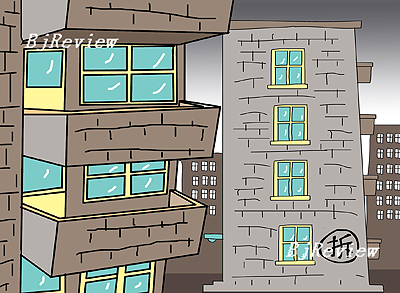
Nobody likes a critic--especially one in a foreign country. There's something deeply irritating about foreigners moaning over local behavior simply because it's different to their own norms. Different doesn't mean better or worse, although that often seems to be the implication.
That's why I'm glad a leading Chinese official has publicly voiced what I have privately thought since I arrived in China. In a recent front page China Daily story, Vice Minister of Construction Qiu Baoxing railed against local governments' wholesale destruction of the country's historical sites and cultural relics. "They are totally unaware of the value of cultural heritage," he noted with disgust during a Beijing international conference on urban culture and city planning. Interestingly, these comments came not from an historian or a conservationist, but from the deputy head of construction.
One of the first Chinese characters I learned to recognize outside my textbooks was chai, roughly "demolish." Take a short walk almost anywhere around Beijing and you will soon come across a wall spray painted with a circled chai character. Some of the buildings earmarked for demolition had it coming--dated, cheaply made tumbledown apartment blocks have no place in the capital's glitzy new business districts. But many other old buildings are solidly constructed with more character in one elaborate roof gable than all their towering new neighbors together. In China's rush to modernize, these low-rise, old-fashioned buildings are seen as blots on the modern cityscape, where prestige and success are automatically associated with newness. But with a bit of effort, they could become stylish oases of charm among their featureless replacements.
"All Chinese cities look the same," replied my American friend with a shrug when I asked her about her trip to a city in Henan Province for a colleague's wedding. I don't know how many times I have heard that and reluctantly agreed. Every Chinese city I have visited that is not a major tourist hot spot does look the same. Cities tend to have a lot in common with each other in any country; but here in China, the similarities go far beyond the usual downtown shopping areas, sprawling suburbs and homogenous central business areas.
Even in well-known tourist towns the beauty lies in the detail, not in the overall impression. In the canal town of Suzhou, in Jiangsu Province, I was disappointed to find that far from being a beautifully preserved relic of the past, as its sobriquet "The Venice of the East" would have visitors believe, most of the city is much like any other in China. Yes, there are some lovely old canal areas linked by leafy lanes, but the visitor has to seek them out amongst the usual urban hodge-podge and rip-off tourist areas.
Lured by photos of Tianjin's historic Western concession areas, I took a short train ride from Beijing, anticipating a step back into a lost era. True, not all the Western-style balconied mansions and grandly imposing commercial buildings of the city's colorful past have been destroyed, and efforts are being made to protect and preserve some of them. But the vast majority has either been knocked down or is in such a bad state of repair that restoration is unfeasible. I was taken aback to find that the house where China's last emperor Puyi lived after leaving the Forbidden City is now home to numerous families and their domestic animals. The brickwork is crumbling, the paneled walls have holes, the roof is caving in, stairs are broken, the ceiling is sagging and the whole place looks in danger of imminent collapse. It seems incredible that this sorry situation has been allowed to come about at such an important historical site.
The local government in Tianjin is finally waking up to the significance of the destruction of its cultural heritage, but numerous irreplaceable buildings have been lost forever, and with them an inimitable part of the city's soul.
As China develops, tighter protection controls are appearing and awareness of the importance of cultural heritage is slowly growing. But at this rate, by the time changes are made to the country's destroy and rebuild mentality, developers will have permanently erased all but the most famous historic landmarks. On behalf of China's future citizens and visitors, I implore those with the power to preserve China's concrete links to the past to please pause before rubberstamping the next chai order, and remember that there will come a day when the old doesn't always mean worse than the new in China.
The author is New Zealander working in Beijing | 